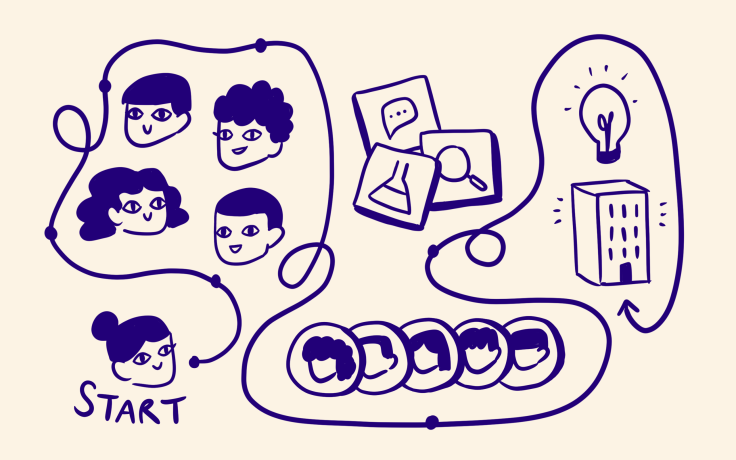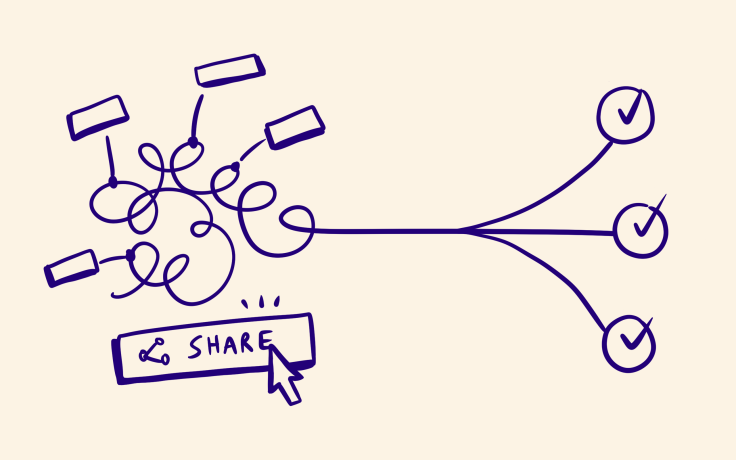Five ways we reinforce our product-led growth model at Dovetail

While the foundation underpinning product-led growth is well understood, we’ve also sought out unique ways that build upon those principles.
In the early days, companies had to build and maintain their own infrastructure and software literally came out of a physical box. More recently, software moved to the cloud, riding the wave of scalable, flexible infrastructure. This sent development costs plummeting and made building new software more efficient than ever. As software development changed, so too did the way software got into the hands of users. The approach a company takes to distribution is often referred to as a go-to-market (’GTM’) strategy.
Roughly a decade ago, a new GTM strategy emerged called Product-Led Growth (’PLG’). End users started to expect the same intuitive interface and delightful experience in the apps they use at work as those they use at home, which was labelled the consumerization of enterprise software. Many of the best software companies recognized this market shift and put end users at the core of their business. Dropbox, Asana, Atlassian, Slack, Shopify, Twilio, Figma and Notion are all great examples of companies that focus on solving the needs of the end user with a delightful solution. These businesses largely distribute their products in a self-serve manner—the end user trying and buying a product with only their email address and the swipe of a credit card. These businesses also realized that if they were going to distribute their product to end users at scale, they couldn’t be dependent on humans to get every person over the line.
This model lets customers—primarily end users to begin with—mature their relationship with a product at their own pace. Typically, the more value they get, the more they are willing to pay. The decision-making criteria of the end user is now based on personal productivity—will this product actually help me day-to-day? It’s imperative to both design and solve problems for the end user. Over time, as more and more end users adopt, engage with, and get value from a product, organizations drive standardization around the access, usage, and administration of that product. In reality this often results in a centralized decision to purchase, roll out, and manage the product.

This growth model of 1) starting with the end user, 2) allowing demand and usage to increase organically or virally to spread to multiple users, then teams, and then departments, and eventually 3) company-wide and centrally managed, is the basis of PLG. While the foundation underpinning product-led growth is well understood, we’ve also sought out unique ways that build upon those principles. Here are five ways we reinforce product-led growth at Dovetail:
Embed product-led growth in our values
Create end user champions
Build inherently viral features
Deliver mind-blowing, fun experiences
Drive efficiency across the board
Embed product-led growth in our values
Our five company values codify how we work together and what we believe in. Many companies have values like these to reinforce culture. We use them to guide how we work, but we also leverage our values to reinforce the core of our business—our product-led growth model.
Our value “if we do it; we nail it” drives a focus on quality, especially on the experience that end users have when initially purchasing and then using Dovetail day-to-day. While most products that follow a PLG strategy can be bought on a credit card in a ‘self-service’ manner, we went the extra mile to ‘nail it’ and built a section on our help center dedicated to purchasing and billing to help people buy Dovetail without talking to a human (or their boss). “If we do it, we nail it” also emphasizes how first impressions matter and how we sweat the details, both of which help remind us to invest in an intuitive experience so that end users reach ‘aha!’ moments quickly.

When we “put the customer first”, we don’t just mean in customer support. Building a deep understanding of what problems end users are looking to solve is a critical component of a product-led strategy, and talking to customers is ingrained throughout our culture—from our product team conducting regular customer interviews through to our sales and customer success teams sharing feedback from sales demos and customer check-ins.
In marketing, we try to be concise and straight to the point (instead of fluffy or vague). Not only does this respect our customer’s time, but it also often results in putting our product front-and-center. Sophisticated end users are the buyers in our product-led growth model, and they don’t want fluff. Figma gets it:
“Authenticity is important with any audience, but I’ve found that especially designers tend to hate traditional SaaS marketing. They don’t want fluff,” says Butler. “We had to think about how we might speak to this audience in a different way, so they understood that we’re not just trying to sell them BS. We are building something that’s going to be useful to them.”
Lastly, our value “open by default” is about much more than internal transparency. We aim to be part of the ‘Age of Connected Work’ by integrating with tools in end user workflows and allowing data portability where feasible. In-product, permissions are optimized for open access. Our pricing is always transparent (even on our Enterprise plan), which makes sales more efficient by removing price negotiation. We maintain a public roadmap which builds end user confidence in the future of the product and publish a lot of security documentation online to help people in a self-service manner.

Create end user champions
We distribute our software via a bottom-up, land and expand growth model. At the heart of this model is the assumption that we can market to, and build a product for, end users, not their managers. To achieve this, our teams are obsessive about understanding the problems our end users face, solving those problems, and always speaking their language. We don’t believe in pushy sales or bullshit marketing — we aim to develop meaningful relationships with our end users through content marketing, community, support, customer success, sales-assist, and of course, our product. The benefit of this approach is that these people build such a strong affinity towards our brand that they become internal champions for Dovetail. They advocate for their teammates and stakeholders to use Dovetail for more projects, more types of research, and ultimately drive the cultural change towards building a better understanding of their customers. Creating champions also means our sales motion focuses on assisting them through their company’s purchasing process rather than selling the product in the traditional sense.
This model of frictionless customer acquisition and internal expansion has far less friction than a top down sales model, but it requires us to constantly deliver real value to earn customer’s trust. This trust is required for them to put their reputation on the line with their peers, managers, and stakeholders. Every minute saved during their analysis process, every meeting where they nail the presentation of their work, every Slack message sharing a new customer insight—all of these moments and interactions build over time to make our champions look good and increase the momentum of Dovetail’s usage in an organization.
A product that generates champions also facilitates connections between those champions in a meaningful way through our community. Our users are often experts in their craft and experts in using our product. They share many of the same challenges in their day-to-day work, shared experiences, and career goals. Bringing people together creates opportunities to share best practices about their craft and our product, and the space to form new relationships. All of that helps us extend the experience people have with Dovetail beyond the product itself.
Build inherently viral features
At its core, Dovetail drives productivity. You can do more research faster, analyze it more efficiently, and generate more insights. But we also believe that customer understanding should be at the core of every product decision and building in inherent virality and collaboration helps researchers be much more impactful. Ongoing usage of Dovetail should drive someone to come back more and more frequently, and engage others in research. After all, customer insights that nobody consumes are pointless. Building ‘inherent virality’ into the core feature set and user journey is key to making that a reality. For example, sharing research outputs should be seamless. Dovetail should integrate seamlessly with other tools so customer knowledge can be embedded in core workflows. It should be simple to trace a piece of customer knowledge to a design in Figma, a ticket in Jira or embed a video highlight in a Notion page.

Deliver mind-blowing, fun experiences
When we set out to build a company, our first long-term goal was to build a product that had an NPS of 100. That is to say, a product that delighted people so much that they couldn’t help but tell other people about it at a family barbecue, a friend’s wedding, or a colleague at work. Shipping mind-blowing (and fun!) features helps us work towards this goal.
This principle shows up in functional features like automatic transcription or video anonymization that fundamentally changes how our users go about their work forever, as well as non-functional experiences in the product like cute illustrations or lighthearted product copy. We take inspiration from consumer products and disagree that B2B software has to be boring and “enterprise-y”.
Mind-blowing features are related to a core belief we have—software should be simple. Easy things should be effortless, and hard things should be possible. When we do both, people are excited to invite colleagues to share the experience. Their colleagues experience the value quickly and seamlessly and become equally excited to share with their network.
To pull this off requires all of us to work closely together to consider the customer experience in its entirety, end-to-end. The best experiences happen when engineering, design, marketing, sales, customer success, and support come together. We measure it as much through someone being blown away by a magic moment in the product as we do through feedback from a Dovetail champion thanking our sales team for helping them purchase Dovetail efficiently.
Drive efficiency across the board
We’re always asking how we can achieve more with less time and energy. We solve problems at their root, avoid solutions that solve one problem but introduce two more, and seek to eliminate entire classes of problems where possible. Often that means engineering effort, but efficiency isn’t limited to a particular discipline. It applies across product, design, sales, support, operations—every part of the business can solve problems at scale.
For example, in support, we strive to have “zero non-unique questions” from customers. This means when we hear something more than once, we go back to the product and make the experience more intuitive or help the next customer find the answer themselves through our Help Center. Our sales process is set up to enable customers to self-serve as many parts of the journey as they can themselves—e.g publicly available security documentation and certifications over bespoke security questionnaires.
Our end user will always be at the heart of everything we do, every decision we make. We’re just getting started on our mission to help our customers improve the quality of every thing, and we believe that a product-led approach is the one that puts the customer first.
A whole new way to understand your customer is here
Log in or sign up
Get started for free
or
By clicking “Continue with Google / Email” you agree to our User Terms of Service and Privacy Policy


